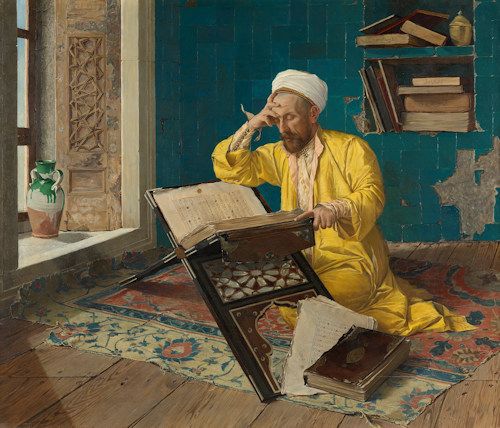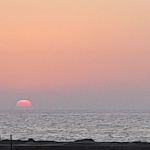Our Eurocentric environment here often blinkers us to the astonishing art history of other parts of the world. An exhibition at Upper Belvedere shines a light on three pioneering painters from beyond Western Europe: Raden Saleh, Hakob Hovnatanyan, and Osman Hamdi Bey.
- Focus on three paintings by three artists who merged eastern and western influences
- Part of the In-Sight series at Belvedere
- Curated by Markus Fellinger
- Runs Sept 9, 2021 – Mar 27, 2022
- See also:
- Current art exhibitions in Vienna
Art of the World

(Osman Hamdi Bey, Meditating on the Qur’an, 1902; press photo provided by and © Johannes Stoll / Belvedere, Vienna)
Given its mandate, location and the provenance of its collections, Belvedere’s art inevitably focuses on Europe. But those same collections contain a few jewels from beyond.
Three such gems form the focal point of the latest in the In-Sight (Im Blick) series of exhibitions that provides a more in-depth look at specific pieces of art.
The displays explore a painting each by Raden Saleh, Hakob Hovnatanyan, and Osman Hamdi Bey, with each of the works illustrative of a certain creative tension between east and west.
As curator Markus Fellinger notes:
They represent a view of European art from the outside and allow us to challenge in many ways the familiar Eurocentric view of the world.
- Raden Saleh (d. 1880) grew up in Indonesia under Dutch colonial rule and many consider him the father of modern Indonesian painting. He studied art and worked in Europe during his early adult life before returning to what was then the Dutch East Indies. His 1870 Tigers Fighting over a dead Javanese features in the exhibition.
- The Armenian artist Hakob Hovnatanyan (d. 1881) turned away from a more European artistic tradition later in his life, eventually following his interest in Persian art by moving to Tehran. The exhibition showcases his 1860 portrait of Naser ad-Din, who ruled as Shah of Qajar Iran for almost 50 years.
- Turkish painter Osman Hamdi Bey (d. 1910) trained in Paris but went on to play a significant role in building up important cultural professions and institutions in Istanbul, including founding what is today’s Mimar Sinan Fine Arts University. The exhibition includes his 1902 Meditating on the Qur’an (see picture above).
History (or rather those that write it) has led to a geographic bias in our perceptions of great art. All the more reason to welcome Belvedere’s decision to shine a light on these paintings and their creators.
As Belvedere’s CEO (Stella Rollig) points out, the exhibition allows the art museum to offer:
…a deeper understanding of the many perspectives of historical works from artists at the crossroads of different cultures.
Dates, tickets & tips
Enjoy a deep dive into the three paintings and the artists behind them from September 9th, 2021 to March 27th, 2022.
A simple entrance ticket for Upper Belvedere gets you into the exhibition. The same location has Belvedere’s glorious permanent collection (Klimt and more). And another temporary exhibition there that runs for much of the same time is The Age of Dürer, which takes you back a few more centuries.
Should you visit from late November or in December, look out for the rather lovely Christmas market just outside.
How to get to the exhibition
Upper Belvedere palace hosts the exhibition, so simply follow the relevant instructions in the Belvedere directions article.
Address: Prinz Eugen-Straße 27, 1030 Vienna
